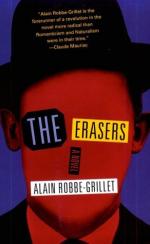|
This section contains 148 words (approx. 1 page at 300 words per page) |

|
It is no accident that the objects in The Erasers have more density than the characters. Whereas more traditional novelists might devote much space to the task of exploring the psychology of their characters, analyzing their thoughts and motives, thereby giving them dimension and depth, RobbeGrillet assiduously avoids giving his readers such insights, directing attention instead to objects: a slice of ham, a quarter of tomato, a gray eraser, a paperweight. If his characters have thoughts, memories, perceptions to which the reader is made privy, these are presented without narrative comment, and nothing of the character's emotional life is revealed. The only referent of consciousness is the object perceived, but perceptions alter with fluctuations in mood and experience; thus, the paperweight which Wallas sees at one point as "polished . . . with rounded edges," later, just before the actual murder of Dupont, manifests "sharp edges and murderous corners."
|
This section contains 148 words (approx. 1 page at 300 words per page) |

|



